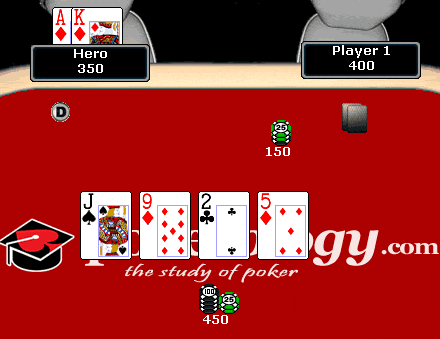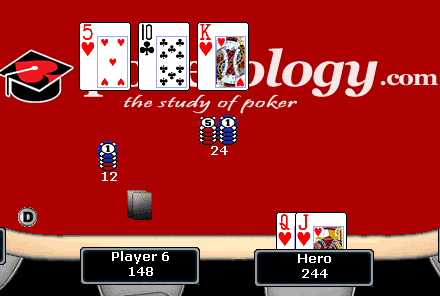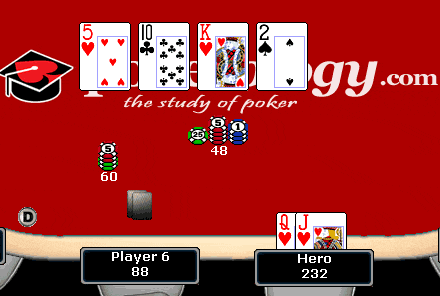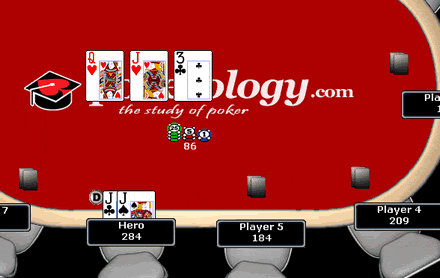Calculating pot odds and implementing it into your games
In poker there are good bets and bad bets – the game is simply a way of determining who can tell the difference. This is where the concept of pot odds comes into play. Put simply, pot odds means is there enough in the pot to call a bet.
The fundamental principle of playing a drawing hand in poker is that you need a pot big enough to call. When we have a flush draw or a straight draw we will make our hand on the next card almost 20% of the time (19% for flush and 17% for the straight draw). That is, 20% of the time we will make our desired hand and 80% we won’t. The ratio 20 to 80 can be expressed as odds of 4-to-1. Therefore, if the pot is $80 we can almost call a $20 bet to break-even. I say almost because we have to make a profit so, a call of $20 is appropriate when there is more than $80 in the pot.
Know the Odds
You should already know how to calculate odds based upon the number of “outs”. If you don’t know the odds of hitting certain common draws then please go back and study our previous lesson on calculating odds and outs in poker.
For the benefit of this lesson we’ll include the handy chart below:

Table: Odds and outs from the flop and the turn to the river
Track the Pot Size
Part of the concept of pot odds is to focus on the calculation of how to figure the odds of your hand becoming a winner. The other part of the equation is to know how much is actually in the pot in order to know what odds it is offering you.
If you’re playing poker online then the size of the pot should be in clear view at all times – simple! If you’re playing poker live then it’s as easy as paying attention and using basic arithmetic to know the pot size at every step of the way. All one needs to do is multiply the total amount bet on each street by the number of active players and add that sum to the blinds if they are not participating in the hand. Hold that total in your head and add the subsequent total of the next street’s betting and you will always have the pot total available to calculate your pot odds. Here are some critical words of advice: know what is in the pot at all times. How else can you make proper mathematical decisions?
Calculating the Pot Odds
At this stage you should know the odds of hitting your card(s) and the size of the pot. The next step is to know what odds the pot is offering you. The best way to teach you is to use an example hand. Take a look at figure 1, below:

Figure 1
As you can see, we have 9 outs for the nut flush draw, so the odds of hitting our flush on the river are roughly 20% or 4-to-1 odds. There is $450 in the pot, and player 2 bets $150, which now makes the total pot $600. It’s going to cost us $150 to win $600. How do we calculate these figures to give us the pot odds? This is fairly simple as 600/150 = 4, so we have 4-to-1 odds for our money.
If we want to know the percentage then we add the bet (call amount) to the pot, to give us a total pot figure. In this example it would be: 150 + 600 = 750. Once we have this figure then we would have to perform the following formula: call amount / the total pot size. In our example this would be 150 / 750 = 0.2, or 20%.
Now we know the pot odds, should we call or not? In our example we can justify the call as we’re getting 4-to-1 pot odds and our odds of hitting and winning is also 4-to-1. But remember it’s a break-even call over the long term if we’re only counting the flush draw. Ideally we’d want the pot to be a little bigger or their bet to be a little smaller. However, if we believe that hitting either an Ace of King (giving us 6 additional outs) on the river would beat our opponent then we’d have more than enough odds to call the bet.
In poker, whenever the pot odds exceed the odds against making your hand, it pays to keep playing. When the odds against your hand coming in exceed the reward associated with it, it’s usually a bad deal. A simple way to think about this is as follows:
When the prize exceeds the cost, you should call.
If the cost is more than the money you figure to win, fold.
Let’s look at another example:

Figure 2
Here we have a straight and a flush draw, meaning we have 15 possible outs. The odds of hitting one of our outs on the turn is 31.9% or 2.13-to-1. The pot contains $36 ($24 + $12) and it’ll cost us $12 to call.
Are we getting enough pot odds to call? Let’s do the figures, first in odds….. $36 (total pot) / $12 (cost to call) = 3. Expressed as a ratio this would be 3-to-1 odds, meaning we’ll win once every 4 times. In percentage terms… the pot odds can be expressed as 25%. Our drawing odds are 31.9%. Since the pot is offering us better odds than our draw, we should call the $12 bet.
Let’s continue with this hand example. As you can see in figure 3, we didn’t hit on the turn, we check and our opponent then bets $60 into the existing $48 in the pot.

Figure 3
Are we still getting the correct pot odds to call in the hopes of hitting a straight or flush? The answer is no.
The pot odds are now 1.8-to-1 (108 / 60) or 35.7% in percentage terms. Our drawing odds are 2.07-to-1 or 32.6%. Since the pot odds are less than the odds of hitting, in this instance we should fold. To call a bet here we’d need the pot to be a little bigger or our opponents bet to be a little lower. He has priced us out with his overbet.
So, that old feeling we had, “There is a bunch of money in the pot, I call”, was and is a sound tactic. Now we know more precisely when it is profitable and when it is not profitable to go in on draws. Knowing pot odds does two things; it lets us concentrate on the other players and turns poker into a game of skill.
Make Your Opponents Pay
Let’s take a quick look at a situation when you’re the one with a made hand and you figure one or more of your opponents to be drawing. Understanding the concept of pot odds should help you to determine an appropriate bet size and charge your adversaries for their possible draws.
Imagine raising a bunch of limpers from late position, holding pocket Jacks. The big blind and the three of the original limpers all call your raise and the five of you watch a flop of QhJh3c.

Figure 4
You’ve hit middle set but there are both straight and flush draws staring at you along with four opponents. There is $86 in the pot and everyone checks to you. You are definitely going to make a continuation bet but you need to decide on how much. Allow me to provide a check list of criteria to think about that as you become more experienced will become so automatic as to not even require any conscious thought.
Know the pot size – in this case $86.
Acknowledge the texture of the flop and tendencies of your opponents in terms of potential threats to your holding. Limpers and callers are many times on draws.
Know the odds to the potential draws the flop offers. In this case both flush and straight draws.
Make a bet that will not offer the potential draws the correct odds.
You should bet the size of the pot, $86, in order to make the odds being offered by the pot only 2-to-1 which would not be attractive odds for draws.
If it is true, and I believe it is, that the bulk of your poker profit comes from the mistakes of others rather than you own brilliant play, then identifying opponents that overpay to draw to their hands is critical information. Aside from just playing too many hands, one of the biggest and most expensive mistakes less experienced poker players commit is paying too high a price to try to make their draws. Ferret this information out by tracking the pot and watching showdowns and then you can determine how to manipulate the size of the pot against that opponent in a future hand.
Tournament Play
Much of what has been offered so far is beneficial for both cash games and poker tournaments. But you should approach opponents in tournaments that are desperate a little differently. In a cash game, being pot committed doesn’t really come into play. The term pot committed simply refers to a player who has half or more of his chips already in the pot so if he loses this pot he is pretty much finished anyway. This player will be calling, not based upon the pot odds, but due to his predicament. Players calling in tournament play without the correct pot odds does not necessarily indicate poor play. Calling may well still represent their best chance mathematically to move forward in the tournament and make some money. Hence the expression, do or die!
The reverse situation relative to pot odds can also occur in tournament play. Imagine being in a situation wherein you have the correct pot odds to call but folding could be the better option to advance. An example of this type of phenomenon would be holding the nut flush draw with one card to come with two other opponents already all-in by a monster stack late in a poker tournament. The pot could be offering you greater than the odds required to make the call mathematically correct but the fact still remains that you will miss your flush 80% of the time. If you were on the bubble with the big stack bully already having two other players all-in and you knew you would only prevail in the hand 20 percent of time – I think a fold would be in order.
Many believe that pot odds aren’t nearly as important in tournament play. This is especially true in the lower stake “fast” events that are typical in both live and internet play. These players focus on the odds of their opponents’ calling based upon the size of chip stacks. While some of this is true, if you begin to ignore pot odds because you are in a poker tournament, you will begin to slide down a slippery slope. If you are planning to make a decision that is not in accordance with good pot odds play, you should have a very significant reason.
Put in the Work
Knowing what and how to use pot odds is essential if you wish to become a winning poker player. Learning how to use these concepts to your advantage can put you well ahead of a vast legion of players that are just too lazy to put in the work. They are playing on feel and their gut instincts and proud of it. I’m happy they’re proud of this approach because I know they can’t be proud of their bankrolls. These “proud” players are the assets you need in both cash games and tournaments. Let them be proud – you should put in the work – you’ll be glad you did as you’ll end up with their bankrolls.
By Tom "TIME" Leonard
Adapted from http://www.pokerology.com/lessons/pot-odds/









